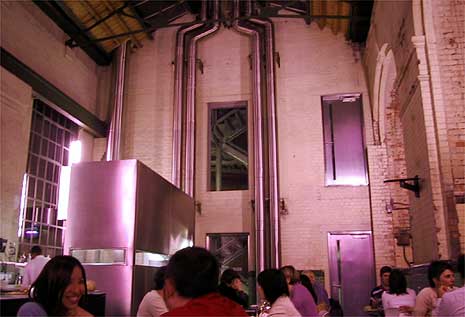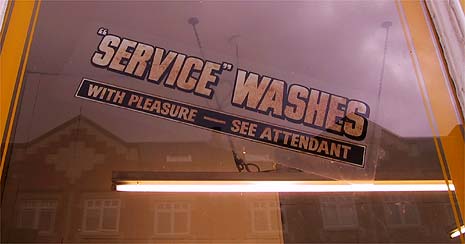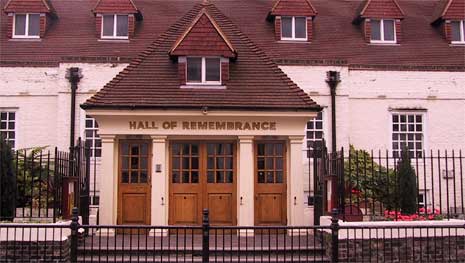| |
||
October 2002 | ||
|
2002.10.30
|
||
|
Herald Square and vicinity, #
|
Herald Square and vicinity, Manhattan. . . .
Something I wrote for MIT's Technology Review: The Web's Missing Links. I've posted it on my site because you need to be a subscriber or pay to read the whole thing on the magazine's site. I've been told that the copyright police are unlikely to bust me for this. The story is about backlinking, or the practice of automatically linking back to the pages that are linking to your page. Weblog people have been playing with this idea for a while, and it has some interesting implications for the wider Web as well. When I started working on this story I added a simple backlinking feature to the right column of this page. One thing I like about it is the feeling of giving up control over a corner of my own site. Someone could follow a link there and discover a new site that I've never even seen. It's all about embracing unpredictability... The related links I would normally post here are next to the article itself. | |
|
2002.10.29
|
||
|
Upper West Side, Manhattan. #
|
Upper West Side, Manhattan. . . .
A tasty ph(f)oto(b)log from Brazil. . . .
The giant Coke bottle in Times Square is coming down. | |
|
2002.10.28
|
||
|
Covent Garden, London, September. #
|
Covent Garden, London, September. So how well does it work? In Shazam's offices it identified MOP's "Cold as Ice" on the radio, but later in a car it failed to get Roxy Music's "Avalon," although the music might not have been loud enough. I also asked a few other people to try it out. Graham (who helped out with EUROTRASH) gave it a shot and posted a mostly positive report on his site. (The Vines' live cover of "Miss Jackson" is not out on CD, which probably explains that failure.) And my friend Garth sent this less glowing analysis: Tried Shazam in the excellent Coal Hole bar on Strand, good volume and clarity and low crowd noise but Shazam failed to identify both Timo Maas, "To Get Down" and Stereophonics, "Handbags and Gladrags." A message came back in 15 minutes saying that Shazam needed the music to be even louder. . . .
Photoblogs.org is a popularity contest. | |
|
2002.10.24
|
||
|
Park Slope, Brooklyn. The #
|
Park Slope, Brooklyn. . . .
Nipernaadi.kolhoos.ee is a photolog by a bunch of radio reporters in Estonia. They used new Ericsson phones with cameras attached and e-mailed their photos straight to the Web -- no computer necessary. There's an explanation in English. It was a summer project so it's now defunct. | |
|
2002.10.23
|
||
|
Soho, Manhattan. . . #
|
Soho, Manhattan. . . .
I wrote this for the NYT's special section on cars today: My Car Sounds Better Than Yours. It's about people who install ridiculously elaborate custom-built MP3 systems in their cars. Some related links: -- Robert Bean's CarMP3 page, with photos of the molding job he did to make it look like the laptop screen in his dashboard was factory-installed. | |
|
2002.10.22
|
||
|
Park Slope, Brooklyn. . #
|
Park Slope, Brooklyn. . . .
These are some rough notes for an essay on photologs and digital photography. I'm writing for a general audience so some of these points are pretty basic. Photologs are a logical development in photography, enabled and encouraged by the spread of digital cameras. The incremental cost of taking photos with a digital camera is negligible. This means people don't have to think twice about generating a regular stream of images by shooting whatever catches their eye. The cameras are getting smaller too, so people are taking them everywhere. Photography becomes more of an everyday thing and not just something you do on birthdays and vacations. The instant feedback of digital turns people into better photographers, and even bad photographers can take good photos with digital cameras because they're quite forgiving of screwups and poor conditions.Feedback is encouraged. | |
|
2002.10.21
|
||
|
Consumer feedback in the East #
|
Consumer feedback in the East Village, Manhattan.
Ad for Dasani on a bus stop.
In a Citibank ATM lobby on a Sunday. . . .
A short thing I wrote for today's NYT business section: Robotic Dogs and Singing Fish in Cross Hairs. It's about Fritz's Hit List, created by Edward Felten, an associate professor at Princeton. The list critiques anti-piracy legislation by Senator Ernest "Fritz" Hollings by pointing out the vast array of "digital media devices" that would be required to have built-in copy protection under the proposed law. My favorite item on the list is the TinkleToonz Musical Potty, which is clearly a must-have for content thieves everywhere. | |
|
2002.10.18
|
||
|
Garment District, Manhattan. . #
|
Garment District, Manhattan. . . .
Water Towers, by Bernd and Hilla Becher. "Since 1957 the Bechers have traveled throughout Europe and North America taking black-and-white photographs of industrial architecture: water towers, coal silos, blast furnaces, lime kilns, grain elevators, preparation plants, pithead gears, oil refineries, and the like." . . .
The PowerPoint Anthology of Literature, by Daniel Radosh. Via Metafilter. | |
|
2002.10.17
|
||
|
Art project in NYU's #
|
Art project in NYU's windows on Broadway, Manhattan. . . .
On a train ride up the Hudson it's hard to miss the spooky medieval ruin on a little island in the river. It's called Bannerman Castle, and its fans have taken some great photos of the place. See also Hudson Valley Ruins. | |
|
2002.10.16
|
||
|
Sunset Park, Brooklyn. . #
|
Sunset Park, Brooklyn. . . .
Noticed in the fine print at ConEd.com: "For electric and gas emergencies please call our toll-free number 1-800-752-6633. DO NOT send us Email." NYC.gov: Department of Umbrellas. Via the informative LockhartSteele.com. | |
|
2002.10.15
|
||
|
Sunset Park, Brooklyn. Shark #
|
Sunset Park, Brooklyn.
Shark fin decor at Jade Plaza.
Box of frogs.
Conchsicles. . . .
Time blurb: "Automated news services can gather headlines in a flash. Is there still room for the human touch? Is there still room for the human touch?" Yes. Yes. | |
|
2002.10.12
|
||
|
| ||
|
2002.10.10
|
||
|
Docklands, London. . . #
|
||
|
2002.10.09
|
||
|
London. Rebecca Horn's "Concert #
|
London.
Rebecca Horn's "Concert for Anarchy" at the Tate Modern. It explodes every few minutes.
Covent Garden.
. . .
| |
|
2002.10.08
|
||
|
Paddington Station, London. See #
|
Paddington Station, London. . . .
Illegal-art.org is the Web site for an upcoming exhibit in New York and Chicago that deals with intellectual property issues. The audio section covers various sampling disputes, some of which I hadn't heard about. Some of the tracks are posted without permission, so check it out before the lawyers show up. Via Copyfight, which is also good. . . .
When plagiarizing from the Web, you should at least read what you're stealing. Via Romenesko. | |
|
2002.10.07
|
||
|
Chelsea, London. . . #
|
Chelsea, London. . . .
Seewhatimtalkingabout.com. Four design students in London get new Nokia phones with cameras in them and bombard each other with tiny photos. Nokia and its marketing firm make a book out of them. Some people are skeptical about camera-phones. I'm not. Via cheesedip.com. . . .
Oops, I spoke too soon. Here's my little story on Meetup from September's issue of Red Herring: Web Users Go Face-to-Face. | |
|
2002.10.04
|
||
|
The Jubilee Line, London #
|
The Jubilee Line, London Underground. . . .
NYTimes.com beefed up its travel section yesterday. The new Destinations pages have a ton of articles on everything from Alaska to Zimbabwe that have been liberated from the pay-to-read archives. | |
|
2002.10.03
|
||
|
London. See also 12.29.2001. #
|
London. . . .
While I was in London, Jonathan hooked me up with some copies of things magazine, which I knew about through its excellent weblog. The magazine's most recent issue has, among other good stuff, a nice essay by Tony Wood on the architectural history of the spectacular Moscow Metro (see someone else's photos). Did you know Moscow has a vast secret subway system that can only be used by government officials? . . .
Clay Shirky says people who want weblogs to make money are a little confused. | |
|
2002.10.02
|
||
|
St. Cross Hospital, Winchester, #
|
St. Cross Hospital, Winchester, Hampshire, U.K.
Founded in 1132, St. Cross is home to 25 poor old men known as the "Brothers."
If you are a traveler and you ask for the "wayfarer's dole," they will give you a mug of beer and a bit of bread.
. . .
I wrote a short thing about Meetup, the brainchild of Scott Heiferman, that was in the September issue of Red Herring. I've been waiting for it to show up on their site so I can link to it. Perhaps the magazine's recent round of layoffs wiped out its Web staff. . . .
Mike C: Signage, Greenpoint, Brooklyn. | |
|
2002.10.01
|
||
|
Winchester Cathedral, Hampshire, U.K. #
|
Winchester Cathedral, Hampshire, U.K. . . .
Flâneur, "a magazine dedicated to the celebration of urban life," has a new issue up. I haven't fully explored it but I did like these photos: Taxi! . . .
"To argue that Morrissey’s contemporary audience skews Hispanic would be inaccurate; Morrissey’s contemporary audience is Hispanic, at least in L.A." Great article in Spin, via Catherine. | |
| |
. . .
|



























































